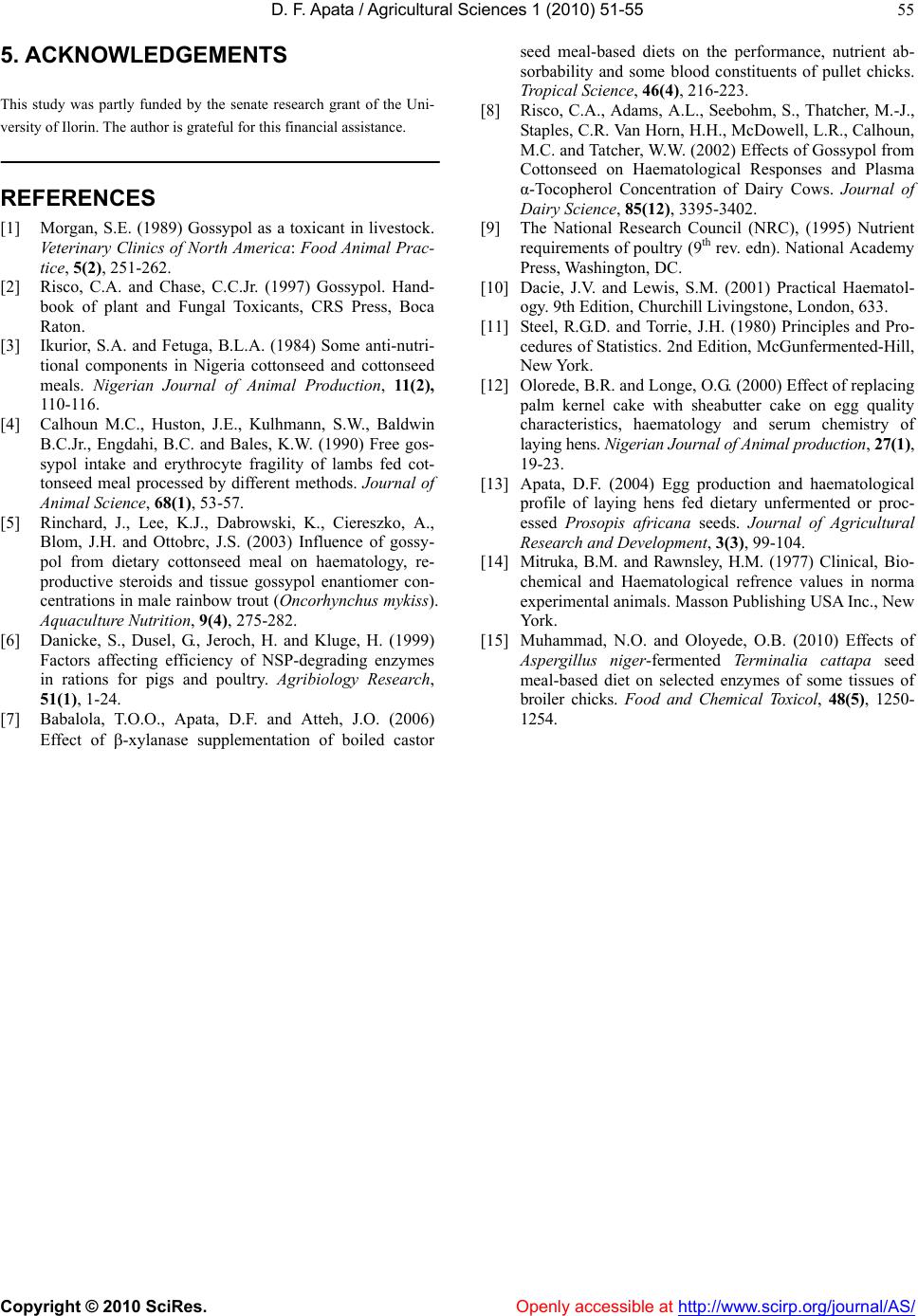
D. F. Apata / Agricultural Sciences 1 (2010) 51-55
Copyright © 2010 SciRes. Openly accessi ble at http://www.scirp.org/journal/AS/
55
5. ACKNOWLEDGEMENTS
This study was partly funded by the senate research grant of the Uni-
versity of Ilorin. The author is grateful for this financial assistance.
REFERENCES
[1] Morgan, S.E. (1989) Gossypol as a toxicant in livestock.
Veterinary Clinics of North America: Food Animal Prac-
tice, 5(2), 251-262.
[2] Risco, C.A. and Chase, C.C.Jr. (1997) Gossypol. Hand-
book of plant and Fungal Toxicants, CRS Press, Boca
Raton.
[3] Ikurior, S.A. and Fetuga, B.L.A. (1984) Some anti-nutri-
tional components in Nigeria cottonseed and cottonseed
meals. Nigerian Journal of Animal Production, 11(2),
110-116.
[4] Calhoun M.C., Huston, J.E., Kulhmann, S.W., Baldwin
B.C.Jr., Engdahi, B.C. and Bales, K.W. (1990) Free gos-
sypol intake and erythrocyte fragility of lambs fed cot-
tonseed meal processed by different methods. Journal of
Animal Science, 68(1), 53-57.
[5] Rinchard, J., Lee, K.J., Dabrowski, K., Ciereszko, A.,
Blom, J.H. and Ottobrc, J.S. (2003) Influence of gossy-
pol from dietary cottonseed meal on haematology, re-
productive steroids and tissue gossypol enantiomer con-
centrations in male rainbow trout (Oncorhynchus mykiss).
Aquaculture Nutrition, 9(4), 275-282.
[6] Danicke, S., Dusel, G., Jeroch, H. and Kluge, H. (1999)
Factors affecting efficiency of NSP-degrading enzymes
in rations for pigs and poultry. Agribiology Research,
51(1), 1-24.
[7] Babalola, T.O.O., Apata, D.F. and Atteh, J.O. (2006)
Effect of -xylanase supplementation of boiled castor
seed meal-based diets on the performance, nutrient ab-
sorbability and some blood constituents of pullet chicks.
Tropical Science, 46(4), 216-223.
[8] Risco, C.A., Adams, A.L., Seebohm, S., Thatcher, M.-J.,
Staples, C.R. Van Horn, H.H., McDowell, L.R., Calhoun,
M.C. and Tatcher, W.W. (2002) Effects of Gossypol from
Cottonseed on Haematological Responses and Plasma
α-Tocopherol Concentration of Dairy Cows. Journal of
Dairy Science, 85(12), 3395-3402.
[9] The National Research Council (NRC), (1995) Nutrient
requirements of poultry (9th rev. edn). National Academy
Press, Washington, DC.
[10] Dacie, J.V. and Lewis, S.M. (2001) Practical Haematol-
ogy. 9th Edition, Churchill Livingstone, London, 633.
[11] Steel, R.G.D. and Torrie, J.H. (1980) Principles and Pro-
cedures of Statistics. 2nd Edition, McGunfermented-Hill,
New York.
[12] Olorede, B.R. and Longe, O.G. (2000) Effect of replacing
palm kernel cake with sheabutter cake on egg quality
characteristics, haematology and serum chemistry of
laying hens. Nigerian Journal of Animal production, 27(1),
19-23.
[13] Apata, D.F. (2004) Egg production and haematological
profile of laying hens fed dietary unfermented or proc-
essed Prosopis africana seeds. Journal of Agricultural
Research and Development, 3(3), 99-104.
[14] Mitruka, B.M. and Rawnsley, H.M. (1977) Clinical, Bio-
chemical and Haematological refrence values in norma
experimental animals. Masson Publishing USA Inc., New
York.
[15] Muhammad, N.O. and Oloyede, O.B. (2010) Effects of
Aspergillus niger-fermented Terminalia cattapa seed
meal-based diet on selected enzymes of some tissues of
broiler chicks. Food and Chemical Toxicol, 48(5), 1250-
1254.